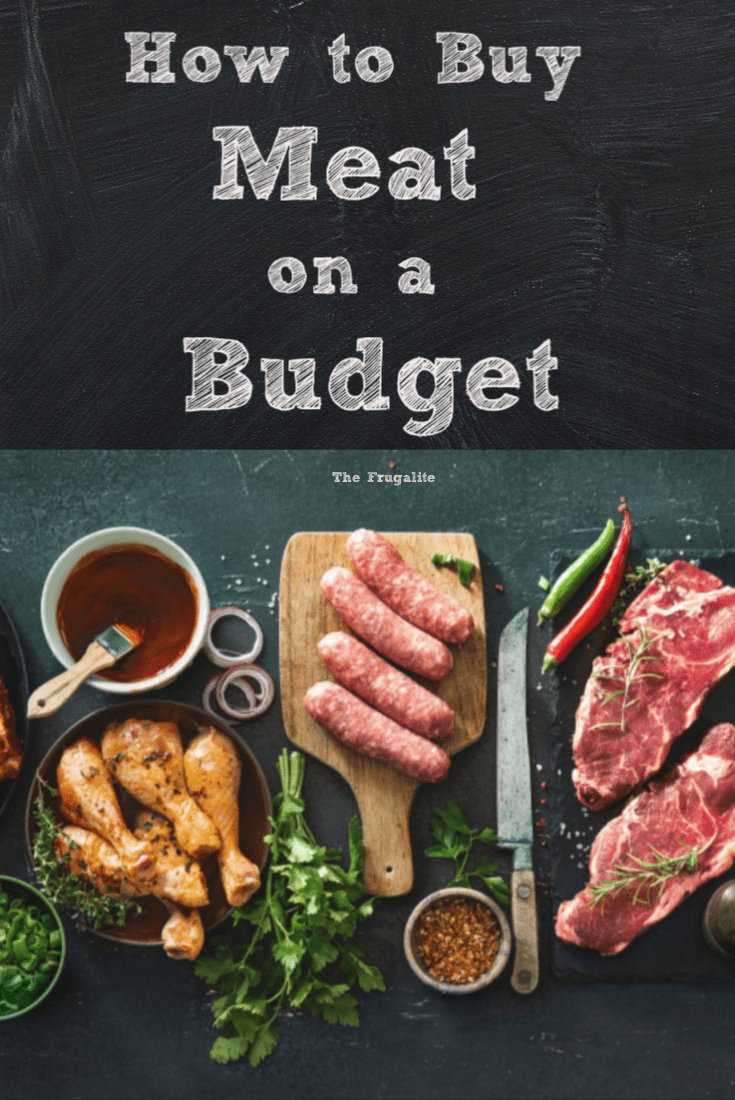(Psst: The FTC wants me to remind you that this website contains affiliate links. That means if you make a purchase from a link you click on, I might receive a small commission. This does not increase the price you’ll pay for that item nor does it decrease the awesomeness of the item. ~ Daisy)
The price of meat is skyrocketing as the supply chain in the United States continues to be shaky. Many readers have reported sparse inventories of meat at their local grocers, and some places are limiting the quantities that you can buy.
Does this mean that you have to become a vegetarian? Does it mean that you have to eschew healthy hormone-free meats and go with the very lowest quality grocery store options?
Not at all.
Here’s a combination of strategies you can use to help your meat purchases go further.
Buy in bulk locally
The absolute best way to buy meat when you’re on a budget is to purchase in bulk and to do so locally. We purchase direct from a local farmer who field-raises his animals and doesn’t use hormones and antibiotics. You can buy a quarter or a half of a pig or cow, and you’ll pay on average a much lower price than you would if you bought the meat packaged separately over the course of the season. As well, you are locking in your meat price by purchasing it all at once. This way, you won’t be strongly affected by meat inflation until next season.
Here are a few tips for bulk purchases of meat
- Check out the farm from which the meat originates. You want animals that were not raised in cramped factory farmed conditions, not fed GMO feed, and not injected with growth hormones and antibiotics. If you are making a purchase like this go for the best quality you can find.
- If that is more meat than your family can use, or more money than you can spend right now, consider going in with another family and splitting the purchase.
- You need a deep freezer in order to make the most of such a large purchase.
- I also like to can meat so that I am not as dependent on my freezer. Look into canning entire roasts, chicken, ham, meatballs, or chili. (You can also check out my canning cookbook for more whole-food canning recipes.)
- Have the poorer cuts turned into stew meat or ground meat.
- Slow cooking a lower quality cut can turn something tough into something that melts in your mouth.
- Learn more about buying meat free of hormones and antibiotics HERE.
Eat leftovers
Often when you purchase meat in bulk, you end up cooking large portions. You probably won’t open a Styrofoam tray of chicken breasts, but instead you’ll purchase a whole chicken. You will be more likely to cook a stew or a roast. Have a plan for what you can do with those leftovers to extend them through another meal. Here are a few quick ideas:
- Make gravy – if you have a serving a meat too small to go around for all of your family members, consider making a gravy and serving it over mashed potatoes. Add some onion and mushrooms to the gravy to extend it even further. Here’s an entire article about the glory of gravy.
- Make a soup or stew – this is another way to extend a serving that isn’t quite big enough to go around. Here’s a universal soup formula to use what you have on hand.
- Mix it with beans and add Mexican seasoning to make burritos or to serve over rice.
- When you make a large roast, thinly slice the meat for sandwiches and salads throughout the work and school week.
- Cover leftover stew with pie crust or biscuit dough for a delicious potpie.
- Look for recipes specifically written to use up leftovers. (This cookbook has my best leftover ideas.)
- If you have more leftovers than you can use before they spoil, sometimes they can be canned – check out the instructions here.
You can find more ideas for repurposing leftovers HERE.
Don’t waste anything
Use up the things that most people throw away. When preparing the meat, if you are cutting away some fat or bone, place it in a bowl and put it in the freezer. When you have enough like scraps of meat, it’s time to make broth from it. You can make hearty broth from ham, turkey, chicken, beef, or pork – virtually any kind of meat. Use the inedible parts and cook it down for hours to get a rich and delicious broth. You can then use this broth as a base for soup or to cook your rice in to add a hit of nutrition.
Here are directions on how to make and can poultry broth and ham broth.
Do you have such a tiny amount of leftovers that it won’t equal a full serving? Start a container in your freezer for those leftovers and create “leftover soup”. Sometimes it’s fantastic, sometimes it isn’t so great, but those odds and ends can combine to make meals that I consider to be basically “freebies.” We always have a large Tupperware container in the freezer that contains little bits of vegetables or meat. Add a jar of homemade broth and a handful of rice, barley or pasta, and you’ve created “leftover soup.” It will be different every single time, based on your family’s leftovers.
Hunt and fish
This answer isn’t for everyone. Some folks prefer to forget that the meat on the styrofoam trays at the grocery store didn’t originate on those trays. Others have gotten locked into a more narrow definition of “meat”, believing that the options are fish, pork, beef, and chicken. However, if you aren’t bothered by the concept of hunting, there is an abundance of meat walking, swimming, and flying around. Invest in a good game cookbook to best prepare meats that may not be familiar to you.
You don’t have to hunt, yourself. I’m fortunate to have some friends and neighbors who hunt. In exchange for some of the bounty, I’ve bartered my skills at canning things like venison chili or moose meatballs in spaghetti sauce.
If you fish, that can put an instant meal on the table. Learning to quickly and efficiently clean fish is a great skill and can gently prepare you for butchering other types of meat.
Perhaps with the sharp uptick in meat prices, it’s time to brush up on these skills and learn to harvest what is naturally abundant in your area.
Any suggestions?
How do you combat the outrageous meat prices? Share your ideas on how to buy meat on a budget in the comments section below.












12 thoughts on “How to Buy Meat on a Budget”
Three specific things I did when my kids were little: 1. soup, 2 stir-fry, (both of these with lots of vegetables!} and 3 refried-bean tostadas, (I would deep-fat fry tortillas, make scratch taco seasoned dry beans, and serve with lots of lettuce, tomatoes, home shredded cheese, canned salsa and sour cream). Freshly made food went over better than canned/take-out.
I do not buy meat weekly or even monthly. I get it a few times a year when there’s a really good sale (often, because it’s the last day they can legally sell it – I find this occurs most often with things like whole pork legs, which can weigh up to 40 pounds). A couple of times a year there is a ridiculously cheap sale on outside round – that is what stew beef is cut from, but it’s much cheaper to buy it whole and cut it up yourself. I butcher at the kitchen counter, vacuum seal smaller roasts and packs of meat in the freezer, and when I have time, thaw and cook up meals to pressure can, like pot roast in a jar or beef stew. Also, whenever I use ground beef in a recipe, I use half ground beef, half mashed lentils. Healthier and cheaper than using all meat, and an extra bouillon cube or two will enhance the beef flavour.
There are usually times during the week (late or early in the day) that grocers will mark down meat that is hitting it’s “Best Buy” date. My local Kroger stores does this. Call and ask your local stores about it. Also call any meat stores in your area and ask how to get a better price. Then take it home and use soon, freeze, or can.
If you have a restaurant supply store that sells to the public, too, then those are the best prices I’ve seen. I’m not sure what chain names might be in other places, but ours is called “Cash N Carry.” You have to buy in bulk, but — for example — I can buy 10# of 80/20 ground beef for around $19… cheaper when they have a sale. Also I get 40# of boneless/skinless chicken breast for around $40.
Granted, their prices may increase as with everyone else’s, but they are always less (in my experience), so if you can’t stock up now, keep them in mind for later.
It’s surprisingly cheap to get a meat grinder. I found a good one for about sixty dollars and you can get a hand crank one for about thirty. Some food processors can be used as well and if you have a Kitchenaid mixer there are attachments you can get. My point with this is, you can turn some really cruddy looking meat into delicious burgers or loose sausage with a fairly small amount of work. It’s a nice option to have. (Obviously not something to do if you’re broke right this second, but if you get a chance – it’s a good thing to buy.)
eat less meat. think of it as a side dish or a flavor additive. maybe 25% of your plate. make 2 veggies, covering 50% of your plate and starch or bread 25%.
We buy our meat from a local farmer (actually a relative) grass fed and does not use hormones or antibiotics, both beef and pork. We buy organically grown chicken at the grocery store. Have found an organic farmer for fryers.
We eat a couple of meatless meals a week and use half of the amount of meat that a recipe might call for. I buy meat a little at a time and have slowly accumulated a good amount
Hi Daisy,
I tried to follow the links in this article, especially interested in the canning roast, etc. The links were not working. Just giving you a heads up. Thanks for your informative info.
Beki
Thank you for bringing that to my attention, Beki! I’ve updated those links and added a couple more 🙂
Meat is even more expensive now, but we are lucky to live in a rural state and our small local stores often buy locally raised and processed meat, as well as purchasing 4-H animals to process — so good meat is available. I always repackage hamburger in 1/2# packages because I just cook for two. One of our favorite recipes is taco soup (think it is sometimes called 5-can soup). We make it with 1/2# hamburger, plus black, navy and pinto beans (I cook dry beans and freeze them in portions) and I throw in a couple handfuls of brown lentils. The recipe calls for diced tomatoes and a can of Rotel — we often just double the diced tomatoes and add a can of diced green chilis. I make my own taco seasoning and ranch dressing mix. This makes a big crockpot of soup — plenty for a couple of meals, plus usually enough to freeze for at least three more meals. I also buy whole chickens, roast them in the crock pot for the first meal, then package the meat for several more meals and make broth from the bones. All those little bits of meat that come off the bones when they are boiled is usually just enough to make a chicken pot pie and there is usually enough meat for at least four or five more meals from the chicken. When chicken breasts are on sale, I cut them up into individual portions — usually two plus a chicken strip from each half breast and freeze them. Lately leg quarters, thighs or legs have been the only thing on sale, so I package those in meal size portions — save all the bones in the freezer and make broth from them as well. I freeze the broth flat in ziploc bags — can break off a small amount as needed or thaw and use the whole bag for soups, gravies, sauces (in place of “cream of” soups), etc. There are many ways to stretch the meat to be able to save money. Another thing we do to stretch the budget is to freeze the extra when we use enchilada sauce, Italian diced tomatoes, green chilis, etc. We would rather freeze half a can of something and make fresh dishes a few weeks from now than eat them as leftovers (some don’t reheat or repurpose very well!)
The “half-a-can” is one of many possible re-uses of virtually any size of tin can — especially if you use a side cutter manual can opener (usually labeled as a “safe cutter” by the marketeers). Its use produces a smooth edge on a reusable can and lid with a smooth edge top that doesn’t cut your fingers like standard can openers have for many decades. I’ve had the best results with Good Cook and Farberware brands while the quality in contrast has been “Walmarted” out of their Mainstay brand so the plastic handle disintegrates in only a few months.
–Lewis